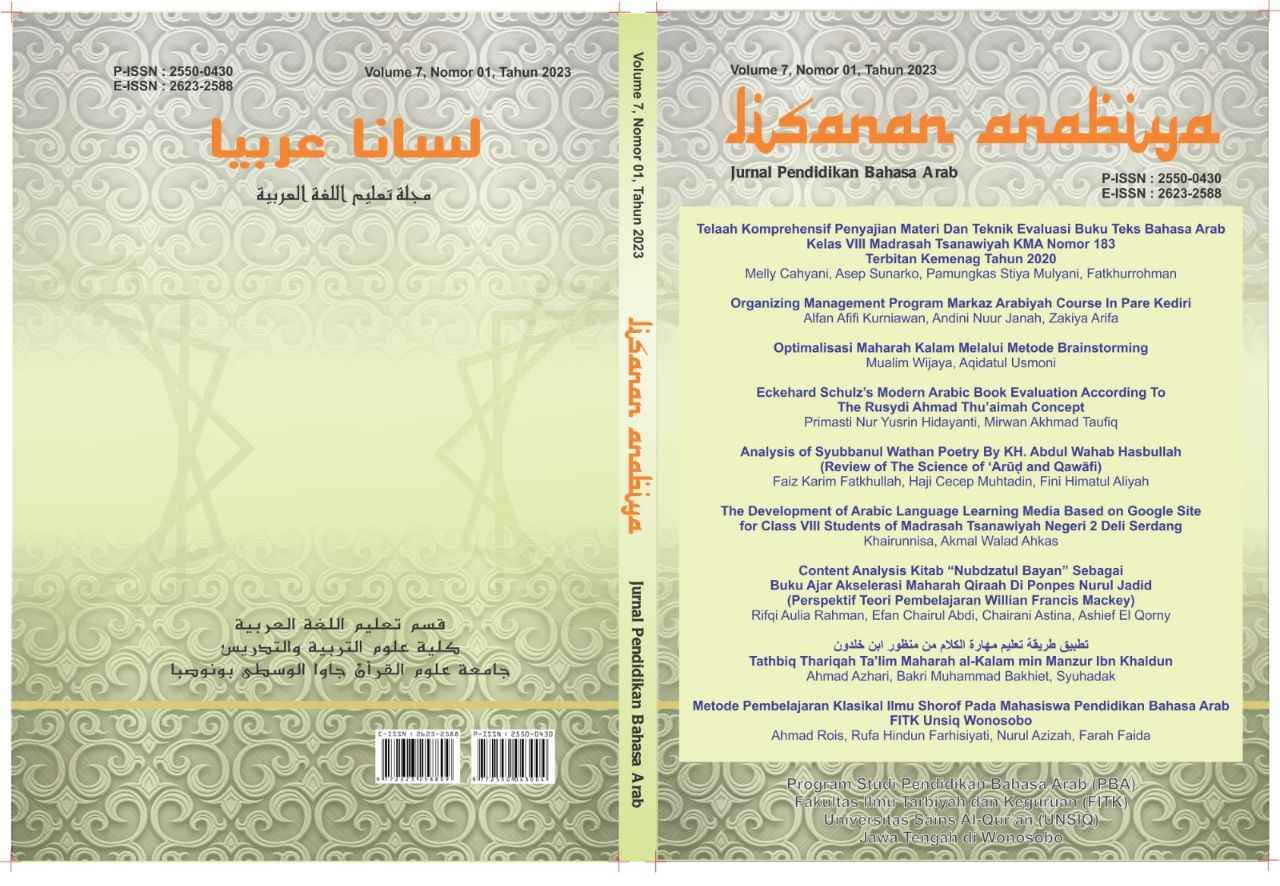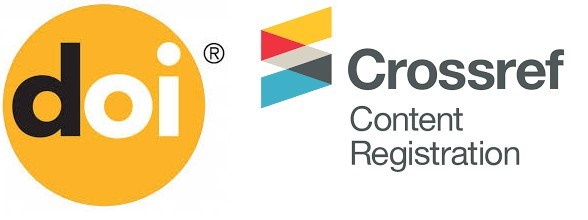Optimalisasi Maharah Kalam Melalui Metode Brainstorming
DOI:
https://doi.org/10.32699/liar.v7i1.4185Keywords:
Brainstorming Method, Speaking Skills, ArabicAbstract
This research was carried out because researchers felt they had found several learning problems in LPBA Nurul Jadid, in the form of many of them feeling bored with the existing methods, and finding it difficult to learn. The purpose of this research is to find out the increase in speaking skills of LPBA students through the use of the Brainstorming method. This research is a case study with a descriptive-qualitative approach, to obtain information about students' speaking abilities through the Brainstorming method at LPBA Nurul Jadid. Collecting data of this research by observation, interviews, and documentation. The results of this study prove that the implementation of the Brainstorming method at LPBA is very helpful for students in improving their speaking skills, students can understand what the other person is talking about better, speak logically and systematically, speak clearly, precisely, fluently and confidently when speaking because have been trained using the Brainstorming method.
References
Amrini Shofiyani, E. M. (2021). Implementasi Media Pembelajaran Bahasa Arab Berbasis Media Ular Tangga Untuk Meningkatkan Hasil Belajar Siswa Di Pondok Pesantren an-Nashriyah. Jurnal Education and Development, 9(3), 229–232.
Ariyanti, Maulana, A., & Damayanti, E. (2021). Pembelajaran Metode Resitasi Dan Brainstorming Sebagai Solusi Dalam Meningkatkan Motivasi Belajar Peserta Didik. Jurnal Biotek, 9(1), 1–10.
Badiah, N., & Anwar, N. (2021). Penerapan Metode brinstorming Untuk meningkatkan maharah al kalam. Academia Open, 4, 1–13. https://doi.org/10.21070/acopen.4.2021.2080
Bakar, K. A., & Yaacob, M. (2018). Tinjauan Literatur Pengajaran Kemahiran Bertutur Bahasa Arab. International Journal of Civilizational Studies and Human Sciences, 1(2), 15–25.
Baroroh, R. U., & Rahmawati, F. N. (2020). Metode-Metode Dalam Pembelajaran Keterampilan Bahasa Arab Reseptif. Urwatul Wutsqo: Jurnal Studi Kependidikan Dan Keislaman, 9(2), 179–196. https://doi.org/10.54437/urwatulwutsqo.v9i2.181
Dahlan, M. (2022). Kemampuan Membaca Pemahaman Wacana Argumentasi Bahasa Indonesia Melalui Metode Belajar Brainstorming. 5151(1), 57–65.
Dariyadi, M. W. (2018). Penggunaan Software “Sparkol Videosribe” Sebagai Media Pembelajaran Bahasa Arab Berbasis Ict. E-Conversion - Proposal for a Cluster of Excellence, 272–282.
Deviana, A. D. (2021). Dampak Belajar Online Menulis Bahasa Arab dengan Berpikir Kreatif Masa Covid-19. Al-Falah: Jurnal Ilmiah Keislaman Dan Kemasyarakatan, 21(1).
Dr. Umar Sidiq, M.Ag Dr. Moh. Miftachul Choiri, M. (2019). Metode Penelitian Kualitatif di Bidang Pendidikan. In Journal of Chemical Information and Modeling (Vol. 53, Issue 9). http://repository.iainponorogo.ac.id/484/1/METODE Penelitian Kualitatif Di Bidang Pendidikan.pdf
Fatimah, S., Mukmin, M. I., & Saifudin, A. (2019). Peningkatan Kemampuan Maharah Al- Qira ’ ah Bagi Siswa-Siswi Kelas VII-K Melalui Model Pembelajaran Inquiri Di Madrasah Tsanawiyah Negeri 2 Malang. Proceding of International Coference on Islamic Education, 4(Mi), 347–356.
Hanifah, U. (2018). Pengembangan Literasi Berbicara Bahasa Arab (Maharat Al-Kalam) di Madrasah Ibtidaiyah (MI). Elementary: Islamic Teacher Journal, 6(2), 206–226. https://doi.org/http://dx.doi.org/10.21043/elementary.v6i2.4383
Harianto, E. (2020). Metode Bertukar Gagasan dalam Pembelajaran Keterampilan Berbicara. Didaktika, 9(4), 411–422. https://jurnaldidaktika.org/contents/article/view/56
Husnatul Hamidiyyah Siregar, Nur Hadi, D. H. (2021). Analisis Pembelajaran Berbasis SAVI (Somatis, Auditori, Visual dan Intelektual) dalam Maharah Kalam. Jurnal Shaut Al-’Arabiyah, 9(1), 32–42.
Iqbal, M. (2018). Penggunaan Metode Mim- Mem Untuk Mengembangkan Keterampilan Berbicara. Al Mi’yar: Jurnal Ilmiah Pembelajaran Bahasa Arab Dan Kebahasaaraban, 1(2), 113. https://doi.org/10.35931/am.v1i2.48
Khaulani, F., Noviana, E., & Witri, G. (2019). Penerapan Metode Brainstorming Dengan Bantuan Media Gambar Grafis Untuk Meningkatkan Hasil Belajar Pkn Siswa Kelas V Sd Negeri 009 Pulau Kecamatan Bangkinang Kabupaten Kampar. Jurnal Pajar (Pendidikan Dan Pengajaran), 3(1), 18. https://doi.org/10.33578/pjr.v3i1.6305
Miftachul Taubah, & Muhammad Nur Hadi. (2020). Aplikasi Tik Tok Sebagai Media Pembelajaran Maharah Kalam. Jurnal Mu’allim, 2(1), 57–65. https://doi.org/10.35891/muallim.v2i1.2201
Moranita, Yulia, Kasih, Fitria, Putra, F. (2022). Jurnal Pendidikan dan Konseling. Jurnal Pendidikan Dan Konseling, 4, 1707–1715.
Mualim Wijaya, Umar Manshur, & Nurul Latifah. (2022). Implementasi Metode Taqdimul Qishoh dalam Meningkatkan Maharah Kalam di Lembaga Al-Wafiyah Kitab dan Bahasa Arab (AWKIBA). Jurnal Mu’allim, 4(2), 220–235. https://doi.org/10.35891/muallim.v4i2.3148
Mubarak, Mahfudz Rizqi , Wahdah Nurul, Ilmiani, Aulia Mustika, H. (2020). Jurnal Zoom.pdf - nurul wahdah. Jurnal Arabiyatuna, 4.
Nanang Kosim, Imam Turmudi, Novy Maryani, A. H. (2022). Pembelajaran Bahasa Arab Melalui Daring; Problematika, Solusi Dan Harapan. Journal of the Japan Welding Society, 91(5), 328–341. https://doi.org/10.2207/jjws.91.328
NAsrulloh, M. F., Nasoih, A. K., Satiti, W. S., Khansa, S., & Afifa. (2020). Mengatasi Problematika Pembelajaran Bahasa Arab melalui Pelatihan dan Permainan Bahasa Arab. Jurnal Pengabdian Masyarakat Bidang Pendidikan, 1(1), 28–35.
Nuril Mufidaha, A. A. F. (2022). Metode Muhadatsah Sebagai Pembelajaran Maharah Kalam Di Madrasah Bertaraf Internasional Amanatul Ummah Pacet Mojokerto. 6(2), 75–91.
Nurlaela, L. fatra. (2020). Problematika Pembelajaran Bahasa Arab pada Keterampilan Berbicara di Era Revolusi Industri 4.0. Prosiding Konferensi Nasional Bahasa Arab, 6, 1.
Padmawati, K. D., Arini, N. W., & Yudiana, K. (2019). Analisis Keterampilan Berbicara Siswa Kelas V Pada Mata Pelajaran Bahasa Indonesia. For Lesson and Learning Studies, 2(2), 190–200.
Pane, A. (2018). Urgensi Bahasa Arab; Bahasa Arab sebagai Alat Komunikasi Agama Islam. Komunikologi, 2(1), 77–88.
Pea, O., Meishanti, Y., Rahmawati, R. D., & Jannah, R. (2020). Pelatihan Berbahasa Arab Melalui Keterampilan Berbicara ( Maharah al-kalam ) Metode Muhadatsah menggunakan Pocket Book. 1(1).
Rahmawati, R., Yusuf, W. A., Khaeruddin, K., Studi, P., Fisika, P., Makassar, U. M., Fisika, J., & Makassar, U. N. (2022). Penerapan Model Problem Based Learning (PBL) dengan Metode Brainstorming untuk Membenahi Pemahaman. SPEKTRA: Jurnal Kajian Pendidikan Sains, 8(1), 27–36.
Rambe, I. W. (2022). Studi Kasus Tingkat Persepsi Siswa SMP Terhadap Pembelajaran Matematika Berbasis Metode Brainstorming di Sekolah. Math-Umb.edu, 9(3), 108–114.
Rista Fauziningtyas, Aldini Yunita Mia Diantami, M. (2018). Efek Metode Brainstorming Terhadap Tingkat Pengetahuan Dan Rasionalitas Penggunaan Obat Swamedikasi. Ners Lentera, 6(1), 55–66.
Shofiyani Amrini, A. K. S. (2021). implementasi brainstorming dalam meningkatkan maharah kalam. 4(4).
Siregar, M. (2019). penerapan metode brainstorming untk meningkatkan hasil belajar. Civitas, 1(1), 1–9. https://doi.org/.1037//0033-2909.I26.1.78
Sunandar, Dwi, E. (2018). Penerapan Metode Brainstorming pada Pembelajaran Fisika Materi Wujud Zat. Jurnal Inovasi Pendidika Fisika Dan Riset Ilmiah, 2(1), 38–42. https://doi.org/10.30599/jipfri.v2i1.209
Ulum, Moh, Zaman, Badruz, Munawwaroh, Wardatul, Ummah, R. (2021). pendampingan pembelajaran BA dengan menggunakan metode mubasyaroh. Jurnal Pengabdian Kepada Masyarakat, 1(2), 120.
Weny Listya JayantiInah, E. N., & Khairunnisa, A. (2019). Hubungan Motivasi Belajar Dengan Prestasi Belajar Bahasa Arab Mahasiswa Bidikmisi. Al-TA’DIB, 12(1), 36. https://doi.org/10.31332/atdb.v12i1.1220
Yusuf, Y., & Trisiana, A. (2019). Metode Braistorming Tertulis: Teknik Curah Pendapat Dengan Memaksimalkan Keterlibatan Semua Peserta Dalam Pengambilan Keputusan. Adi Widya : Jurnal Pengabdian Masyarakat, 3(2), 108. https://doi.org/10.33061/awpm.v3i2.3365
Zaki, M. (2021). Urgensi Bahan Ajar Bahasa Arab sebagai Penentu dalam Proses Belajar Mengajar. Jurnal Al-Af’idah, 5(1), 92–104.
Downloads
Published
Issue
Section
License
Authors who publish with this journal agree to the following terms:
a. Authors retain copyright and grant the journal right of first publication with the work simultaneously licensed under a Creative Commons Attribution-ShareAlike 4.0 International License. that allows others to share the work with an acknowledgement of the work's authorship and initial publication in this journal.
b. Authors are able to enter into separate, additional contractual arrangements for the non-exclusive distribution of the journal's published version of the work (e.g., post it to an institutional repository or publish it in a book), with an acknowledgement of its initial publication in this journal.
c. Authors are permitted and encouraged to post their work online (e.g., in institutional repositories or on their website) prior to and during the submission process, as it can lead to productive exchanges, as well as earlier and greater citation of published work (See The Effect of Open Access).












